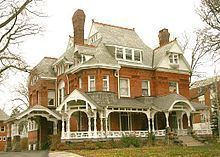Area 85 ha | ||
 | ||
The Old West End is a historic neighborhood in Toledo, Ohio and is considered to be "the largest neighborhood of late Victorian, Edwardian, and Arts & Crafts homes east of the Mississippi." The south end of the neighborhood is bounded by the Toledo Museum of Art and the eastern edge by churches of many denominations on Collingwood Boulevard. The area has homes varying in area from 1200 to 10,000 square feet (930 m2).
Contents
Map of Old West End, Toledo, OH, USA
History
In 1818,the first log home was built in the area now known as the Old West End; then in 1829, the first tavern and store were built.
The Old West End was platted in 1866; "the wealthiest and most well-to-do of Toledo began moving away from their former downtown homes to live in this new development far from the city". The Old West End "experienced most of its growth between 1875 and 1915."
By the late 1870s, the area became a very popular place to live; "...families began to build 'out in the woods' in the West end.” In the heyday of the neighborhood,“Collingwood Avenue became known as the Avenue and eventually as the Avenue of Churches", because of all of the churches that lined and still line Collingwood Avenue.
Unfortunately, in the 1920s and 1930s the area was no longer considered the in vogue neighborhood, and in the 1960s the neighborhood was significantly impacted by the development of the interstate highways. “The construction of the I-75 expressway resulted in the demolition of entire blocks...” The decline of the neighborhood was apparent by the end of the 1960s.
Like most established U.S. cities, Toledo's historic areas saw a time of decline prior to revitalization, but the residents of the Old West End have prevailed in keeping many of the historic landmarks from being demolished. Their efforts paid off; in 1973, part of the Old West End were placed on the National Register of Historic Places as a historic district; this district was expanded in 1984.
From the 1970s the Old West End neighborhood became home to a broadly diverse population of established families, elderly residents, artists and those interested in the arts community. The community also includes singles, minorities, and immigrant residents. There has been an ongoing trend to restore homes in the neighborhood. Many Toledo-based artists and art aficionados reside in the neighborhood in part due to its close proximity to the Toledo Museum of Art.
